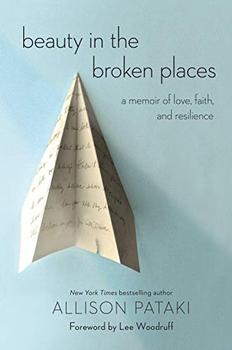Summary | Excerpt | Reading Guide | Reviews | Beyond the Book | Read-Alikes | Genres & Themes | Author Bio

A Memoir of Love, Faith, and Resilience
by Allison PatakiThis article relates to Beauty in the Broken Places
Most strokes are caused by blockages in blood vessels, either directly in the brain or traveling from elsewhere in the body to the brain; these are referred to as ischemic strokes. A minority are caused by ruptured blood vessels (hemorrhagic strokes). It is important for doctors to identify the specific type of stroke that a patient has suffered before deciding on a treatment course as the treatment for ischemic strokes generally focuses on thinning the blood which would make a hemorrhagic stroke worse.
All strokes cut off blood supply and thus oxygen to the brain, causing some brain cells to die and leading to memory loss and numbness. Confusion, difficulty speaking, and partial paralysis can also result. The "FAST test" is a quick way to assess whether someone is having a stroke. Does their Face droop to one side? Can they hold their Arms up? Are there problems with slurred Speech? If one of these signs is present, it's Time to call for an ambulance.
Allison Pataki wrote Beauty in the Broken Places after her husband, at age 30, suffered from a bithalamic midbrain ischemic stroke, a type virtually unknown in people that young.
Here's a closer look at the types of ischemic strokes:
Hemorrhagic strokes involve bleeding in the brain. A weakened blood vessel ruptures, often due to uncontrolled high blood pressure. Other causes are burst aneurysms (balloon-shaped bulges in an artery) or arteriovenous malformations (abnormal tangles of blood vessels connecting arteries and veins). The most common subtype is intracerebral, when an artery in the brain bursts; rarer is a subarachnoid hemorrhage, in which there is bleeding in the space between the brain and its covering tissue. Symptoms can include a sudden, severe headache, along with nausea, dizziness, or a loss of consciousness.
Risk factors for all types of stroke are smoking, which damages and blocks blood vessels; high cholesterol, which can lead to blocked arteries; and obesity. Diabetes also doubles the risk of stroke. People over 60 are much more likely to have an ischemic stroke, and there can be a family history of this type of stroke.
One in eight people die within 30 days of a stroke, but the sooner treatment is sought, the better the chances of a full recovery. TIAs are treated with anticoagulant medication. If an ischemic stroke is caught within three hours it can be treated with IV medication to break down blood clots. Another strategy is to physically remove the clot in surgery. The treatment of hemorrhagic strokes depends on the severity. In the case of minor bleeding, rest and physical and/or speech therapy may be sufficient. In more serious cases, surgery may be required to stop the bleeding, repair the blood vessel and/or relieve pressure on the brain.
Filed under Medicine, Science and Tech
![]() This "beyond the book article" relates to Beauty in the Broken Places. It originally ran in July 2018 and has been updated for the
May 2019 paperback edition.
Go to magazine.
This "beyond the book article" relates to Beauty in the Broken Places. It originally ran in July 2018 and has been updated for the
May 2019 paperback edition.
Go to magazine.
Your guide toexceptional books
BookBrowse seeks out and recommends the best in contemporary fiction and nonfiction—books that not only engage and entertain but also deepen our understanding of ourselves and the world around us.